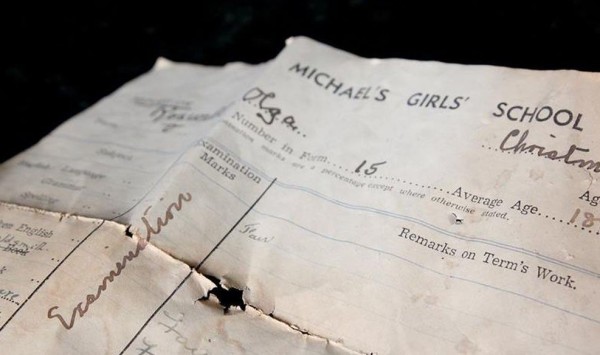THE HOLDOUT (1958)
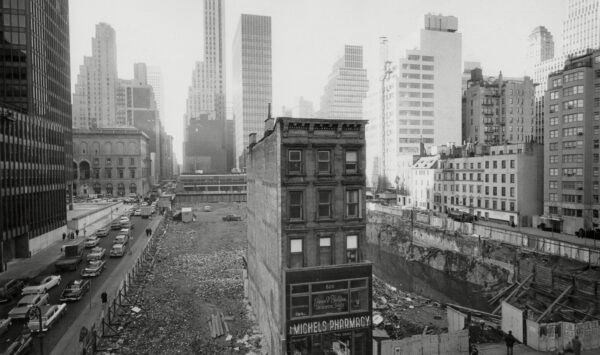
******************************************************************************************************************************** Brownstone Detectives investigates the history of our clients’ homes. The story you are about to read was composed from research conducted in the course of one of those investigations. Do you know the history of YOUR house? ******************************************************************************************************************************** NEW YORK — The Michels family is too steeped in its materia medica and too deeply rooted in its neighborhood to give up its oM-tashioned pharmacy to make way for anything like a 75 nullion dollar office building. Not even for $400,000. The Michels family owns a narrow five-story brownstone building at 620 Lexington Ave. A 42-story office building is going up on both sides and in back of the little brownstone. Negotiators for Vincent Astor, who owns the controlling interest in the Astor Plaza project, have bean trying for five years to induce the family to vacate the pharmacy they own on the ground floor and sell the building for $400,000. Mr. and Mrs. Jacob Michels and their son, Myron, are all registered pharmacists and long-time residents of the neighborhood. And they don’t want to move. But their holdout is just a roadblock in the path to progress in the eyes of the financiers, engineers, architects and contractors erecting the office building. The Michels brownstone is the only building remaining on the square block between Park and Lexington Avenues and 53rd and 54th streets. “We want to stay right here,” Mrs. Michels, a tiny, gray-haired woman, said yesterday. “We told the Astors we would sell the property if they make […]
WOMAN ON A LEDGE AT No. 97 MACON ST (1953)
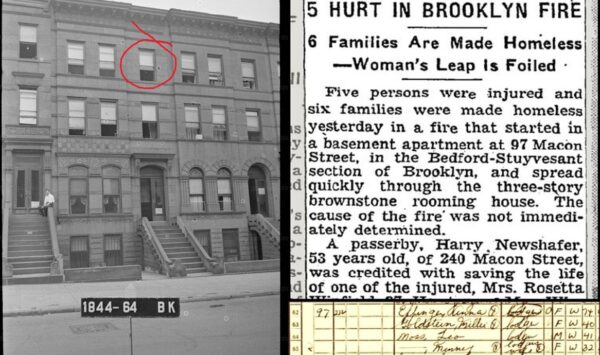
******************************************************************************************************************************** Brownstone Detectives investigates the history of our clients’ homes. The story you are about to read was composed from research conducted in the course of one of those investigations. Do you know the history of YOUR house? ******************************************************************************************************************************** All houses have a history. Those of a certain age clearly have it in spades. One part of any house’s history are those incidents that occur without planning or preordination. They can be unpleasant to know. One of those unplanned incidents, is the housefire of unknown origin that spreads uncontrollably through a residence. One such fire which spread throughout a building, took place on a cold January day in 1953 in a rooming house on Bedford-Stuyvesant’s No. 97 Macon Street. FROM A SINGLE-FAMILY TO A ROOMING HOUSE By 1953, Bedford-Stuyvesant’s brownstone stock was ageing – and it was not doing so gracefully. A large percentage of this section of Brooklyn’s brownstones had passed their semicentennial and were still wired and plumbed as they had been when they were constructed. While many of them had been maintained through the first 30-40 years, as earlier owners moved out and were acquired by owners who began to rent out rooms, however, these newer owners put little money into their maintenance, preferring to squeeze as much profit as possible out of their rent rolls. The Depression-era programs of redlining and blockbusting brought many unsavory characters into the business of making money through the purchase and management of brownstones in black-majority sections – as well as […]
THE WHITE ELEPHANT OF AVENUE “O” (1914)
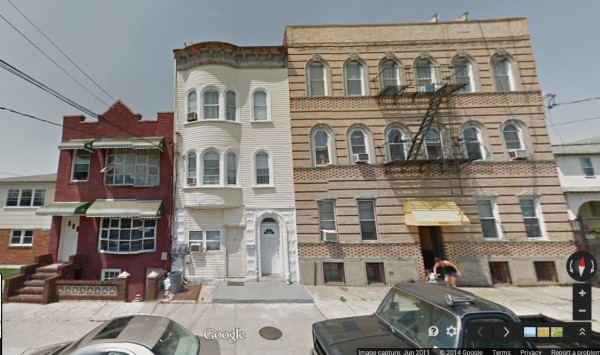
******************************************************************************************************************************** Brownstone Detectives investigates the history of our clients’ homes. The story you are about to read was composed from research conducted in the course of one of those investigations. Do you know the history of YOUR house? ******************************************************************************************************************************** We came across an old newspaper photograph from 1914, republished 30 years later in an old newspaper in 1954. This picture not only celebrates our first entry for a house in the Flatlands section of Brooklyn, but it specifically illustrates a “long-familiar landmark in Old Flatlands.” So noted the text accompanying the picture in the Old-Timers section of the Brooklyn Daily Eagle from May of 1954. Having stumbled across this interesting picture, we were curious to learn if the 2-story and basement structure in question – No. 5407 Avenue O, Brooklyn – was still there, and, by the way, if it was still “white.” So, we looked the address up on Google Maps, expecting to find a shopping mall or a 1940s era soap factory, and – miracle of miracles – there it was! There is a “newer” house to the left of it now, and it seems to have been faced with some vinyl siding (yes, white), but the house appears to be largely as it was back in 1914. The story accompanying the pic in the 1954 article reads as follows: “THE OLD WHITE ELEPHANT”-This picture, taken in 1914, shows a long-familiar landmark in Old Flatlands located at 5407 Avenue O.” COMPLETE FAMILY “The Di Carlo family is shown. […]
AUNT CAR vs. THE IMMIGRATION ACT OF 1917
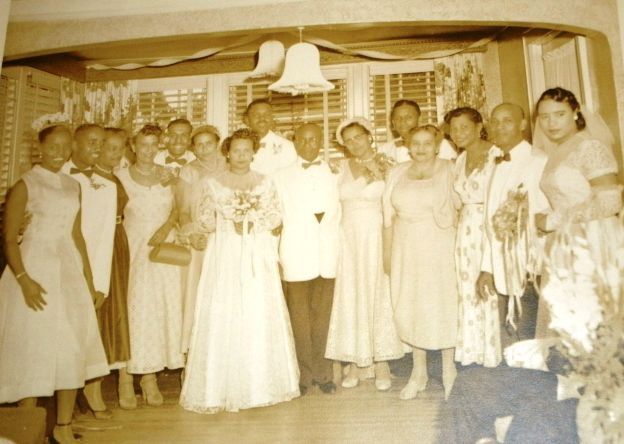
******************************************************************************************************************************** Brownstone Detectives investigates the history of our clients’ homes. The story you are about to read was composed from research conducted in the course of one of those investigations. Do you know the history of YOUR house? ******************************************************************************************************************************** (In the process of writing a House History Book, we research the history of a home’s owners. While researching one particular brownstone, we discovered that – soon after purchasing her brownstone in the 1950s – the Federal Department of Justice issued a warrant for one owner’s arrest and deportation. Sadly, this was not a rare event in Bedford-Stuyvesant at the time.) JAMES GILL MEETS “AUNT CAR” It was probably at some point after James Henry Gill, a mechanic from Trinidad, had registered for the Selective Service in 1942 that he met Caroline Beatrice McLean. McLean, a former schoolmarm from Barbados was then working as a garment worker and living with her sister in an apartment in Harlem. The exact date, time and place of the encounter is lost to the ages. What we do know, however, is that once they did meet they made a great match. Eventually, the couple would take the “A” Train – soon to become famous by way of Duke Ellington’s song – to Bedford-Stuyvesant. Once in Bedford-Stuyvesant, they moved into a brownstone at No. 9 Arlington Place, close to Bedford Avenue. MOVING TO MACON STREET A few years later, on 15 May of 1951, James and Caroline purchased 738 Macon Street from the former owners, the […]
WHEN BROOKLYN WAS (PRE-) FAB (1946)
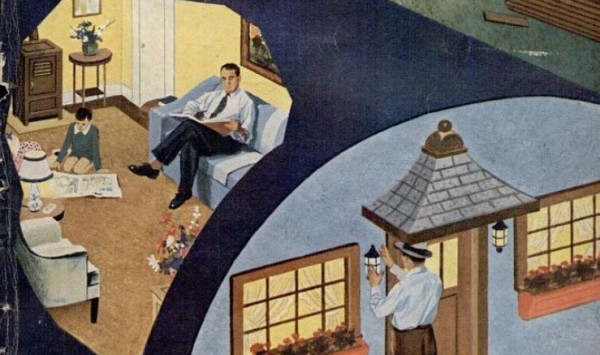
******************************************************************************************************************************** Brownstone Detectives investigates the history of our clients’ homes. The story you are about to read was composed from research conducted in the course of one of those investigations. Do you know the history of YOUR house? ******************************************************************************************************************************** When Johnny came marching home again – he found a housing shortage. As World War II ended right on the tail end of the Depression, the City of New York realized it had a crisis on its hands. Relatively little housing had been built in the previous 15 years and suddenly, with the war winding down, veterans would be returning en masse to a “smaller” city. Robert Moses proposed the temporary solution that seemed to perfectly address the veteran housing shortage – quonset huts. Servicemen would certainly be familiar with them – those curved corrugated “shacks” so familiar to the boys who fought in the Pacific. Used there as quickly built administrative offices and barracks, they were the solution for an army “on-the-go.” But would veterans want to live in them – again? BROOKLYN’S HUTS GO UP In Brooklyn, after much heated debate as to what to build, where, and for how much, acres of land in Canarsie, Jamaica Bay, and the area along the Belt Parkway in the south of Brooklyn, were all selected upon which to build temporary public housing in the form of the Federal surplus quonset huts. These structures, with their curved, corrugated roofs, potbellied stoves in each living room for heat, and a common ground between […]
THE “GOODFELLAS” OF CUMBERLAND STREET
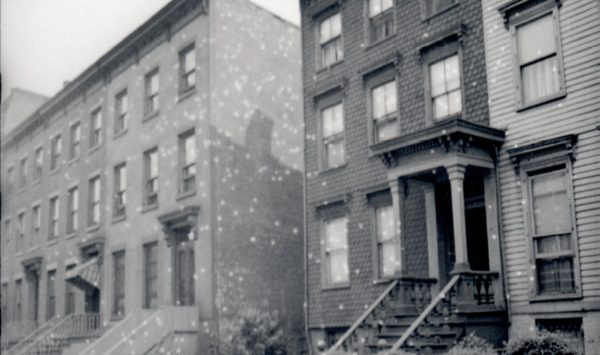
One of the Brownstone Detectives’ first House History Books, No. 231 Cumberland Street: The Story of a House, tells the story of an 1852 antebellum frame home just steps from Fort Greene Park. It’s an action-packed tome, replete with treachery, “poudrette,” “small art,” SROs, and the gangland figures from “Goodfellas.” Here is a brief timeline of the history of this single landmarked property, matched up with “spreads” from the book: THE HISTORY OF A BROOKLYN HOUSE The land beneath which No. 231 would someday rise, started out as a tobacco farm owned by the first Italian immigrant to New York, Pietre Cesare Alberti. The farmland would eventually be built upon in 1851-2, when builder John Ross constructed a row of three homes there. First owned by a woman with a tragic history, a melodrama involving treachery, another man, and an infant daughter – which became the gossip of the newspapers of the time – No. 231 was rented out throughout the the 1850s and 1860s, in addition to many returning Civil War veterans, to merchants and their small families. One of those merchants featured prominently in the founding of the Lafayette Avenue Presbytery Church. Before this, however, he had begun his interesting career as a Night Soil Man – starting a company which, amongst other “agricultural” endeavors, collected human excrement from the backyard privvies of Brooklyn, selling this “compost” to Long Island farmers as the appropriately – if euphemistically – named “poudrette.” The property was then owned by an immigrant, […]
WAS POT GROWN IN THIS BROOKLYN PARK? (1952)
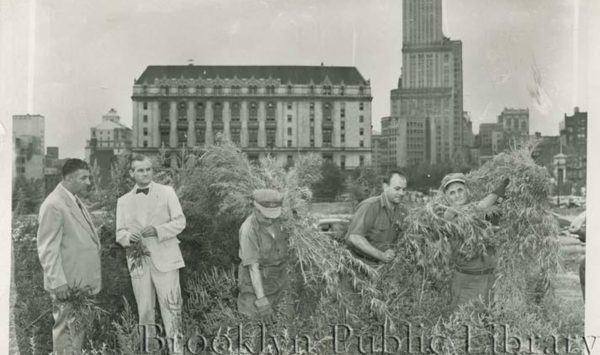
******************************************************************************************************************************** Brownstone Detectives investigates the history of our clients’ homes. The story you are about to read was composed from research conducted in the course of one of those investigations. Do you know the history of YOUR house? ******************************************************************************************************************************** Around the 1920s, Americans began to become aware of “hop.” Known alternatively as “marihuana,” the “loco weed,” “drugged cigarettes,” and a laundry list of other names, the narcotic became the focus of Fed struggles in the ’30s as its use became widespread. Raids were conducted, while drug-crazed citizens went on “1-man riots” because of the drug, and a herd of milk goats grazed on a “5-acre crop” of it at Floyd Bennett Field. In the end, though, the marijuana craze would become a difficult crop to spike. By the 1950s, raids had become an almost daily occurrence, and the City of New York was cooperating with Federal agents as it turned to conducting “operations” of its own to locate and destroy large crops that seemed to be growing just about everywhere in Brooklyn and Queens – mostly on vacant lots. A BROOKLYN PARK GROWS WEED At one point, the City conducted a public campaign with the Sanitation Department and the Police Department at the lead. The police did the locating and the sanitation workers did the destroying. During one raid, in 1952, a rather large marijuana crop seemed to be growing in a wide open park area “in the shadow of the Brooklyn Federal Building, one block north of Tillary St.” […]
THE METAMORPHOSIS OF A BROOKLYN BLOCK
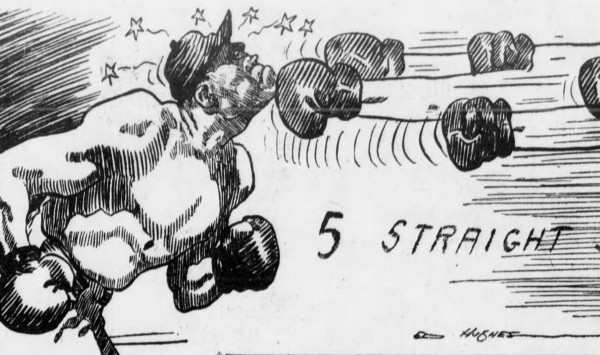
After showcasing some serious open-air ball playing, Saratoga Field was about to go indoors. There it would bear witness to a number of more diverse activities – dancing, fighting, and dreaming. But not necessarily in that order. By 1912, the owners of the block that Saratoga Field had utilized would realize the cash potential of developing the grounds for its marketing to commercial investors. Accordingly, they divided the land up into lots and sold it all off to real estate developers. Shortly afterwards, three new entertainment businesses would appear on the block – the Broadway Boxing Arena, the Halsey Theatre, and the Arcadia Dance Hall, all just across the street from the Brooklyn Rapid Transit (BRT) carbarn and Saratoga Square. THE BROADWAY ARENA The Broadway Arena (also known as the Broadway Sporting Club and the Broadway Exhibition Association Building) sat next to the Halsey Theatre (an alley in between), operating for close to 40 years. It was built around 1912 and had a capacity of 4,500 people. It would become Brooklyn’s top fight arena in the 1930s and 1940s, exhibiting the boxing skills of some of the country’s more well-known fighters, such men as Al Tiernan, Arturo Godoy (who fought Joe Louis in 1940), and Pete Sanstol. By 1951 the Broadway Arena was closed, the victim of competition from the television set. Its last boxing match was held on 29 November 1951. THE HALSEY THEATRE The Halsey Theater, a 2,100-seat theater, which originally presented both vaudeville and silent movies, was […]
